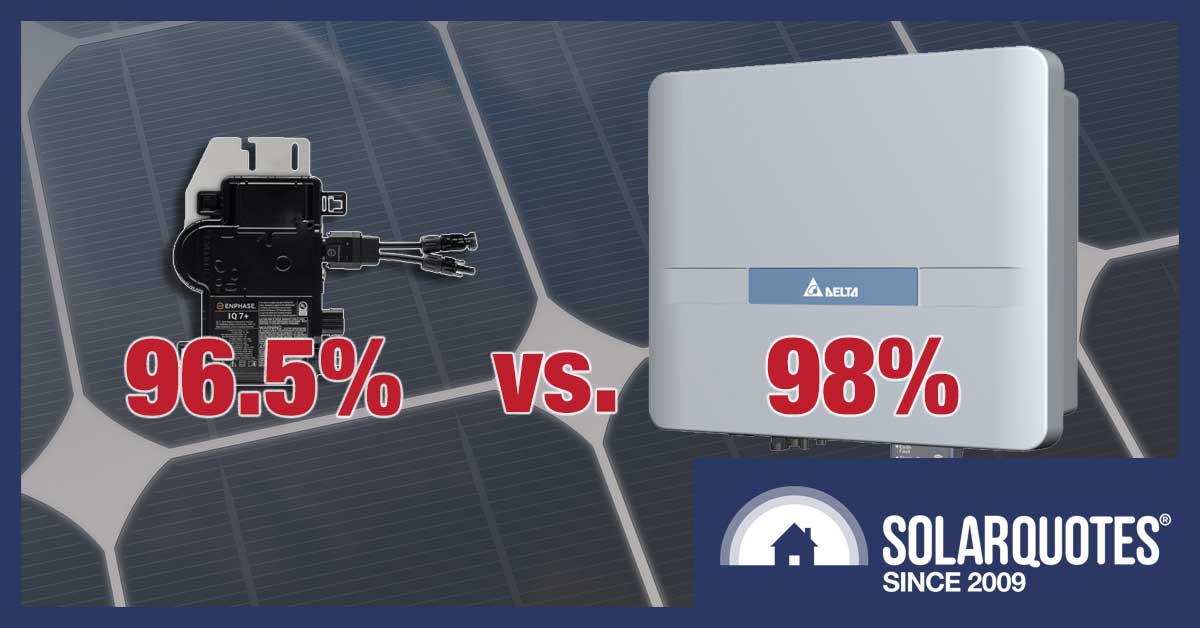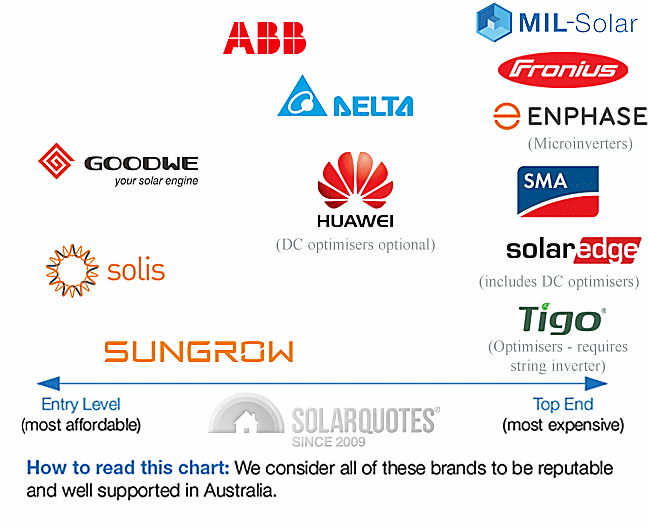
How much can you save over 10 years by choosing a higher efficiency solar inverter?
A solar inverter’s efficiency determines how much solar electricity will be lost on the short journey from your solar panels to your switchboard.
The efficiency of popular Australian residential solar inverters varies from 96.5% to 98%. Higher efficiency lets a home squeeze more kilowatt-hours of generation out of its solar power system. While definitely not the only consideration when buying an inverter, I’d say it doesn’t receive as much attention as it deserves.
To help you decide if an inverter with higher efficiency is worthwhile, first I’ll provide some information on the topic, and then I’ll calculate:
- How many extra kilowatt-hours a one percentage point higher efficiency will generate from a 6.6 kilowatt solar system in each Australian capital, and…
- An estimate of how much money this may save over a 10 year period for each capital.
While I can work out how many extra kilowatt-hours will be generated pretty well, the figure for 10 year savings will only be a rough estimate because it’s not possible to know what the future will bring. But I’ll provide it anyway, because it’s better than having no estimate at all.
If the system you’re considering isn’t 6.6 kilowatts in size this information is still be useful. The figures just have to be proportionately adjusted. If you have an 8 kilowatt system, then bump them up by 20%. Or 21.1212% if you are Annoyingly Never Allowing Latitude.
European Efficiency Not Maximum Efficiency
Inverter datasheets normally have two numbers for efficiency – maximum efficiency and European efficiency. The maximum efficiency figure is the best the solar inverter can do when all the stars align and isn’t very useful. European efficiency is its average performance under reasonably realistic circumstances. It’s the more useful figure and the one I use in this article. If you want to look up the standard so you can read it yourself, I have two pieces of information for you:
- The standard’s code is EN 50530
- You are even weirder than I am.
While having an average efficiency figure based on Australian conditions and temperatures here would be better, the European efficiency figures are still useful and are the standard used by the industry. (There is the Californian Energy Commission standard which would probably make more sense for Australia than the European one that’s based on conditions in Italy, but it hasn’t really caught on.)
A List Of Solar Inverter Efficiencies
Here’s a list of European efficiencies for a range of inverters. With one exception these are all either 5 kilowatts or close to it, single phase inverters; the most commonly installed type in Australia. The exception is the Enphase microinverter which is 295 watts:
- Delta Home Series: 98%
- Huawei Smart Energy Center: 98%
- Sungrow SG5K-D: 98%
- Solis 3P5K: 97.8%
- Goodwe DNS: 97.5%
- Fronius Primo: 97.1%
- ABB Uno: 97%
- Enphase IQ7+ microinverter: 96.5%
- SMA Sunnyboy: 96.5%
- MIL-Solar Eclipse: 96.3%
The Enphase microinverter is near the bottom of the list, but as microinverters provide some advantages they’re not directly comparable to the other solar inverters.
If you are wondering where I got this list from, I lifted it from the MIL-Solar inverter review I wrote last week. All the information is from the manufacturer’s websites, so if it’s wrong it’s their own fault. The reason why I chose these inverter brands is because they are all on our recommended inverter chart from our Solar 101 Guide:
There is an inverter brand missing from the list of efficiencies above and I’ll put it here:
- SolarEdge 98.8%
That is a very impressive efficiency, but the reason I left it off is because every panel in a SolarEdge system must have a SolarEdge optimiser on it. Under the right circumstances, such as heavy shading, these can improve a system’s output, but without shading they may reduce output. I wrote about a study that looks into solar panel optimisers here.
The Bigger The Better
Larger solar inverters with more kilowatts of capacity generally have slightly better efficiencies, while smaller ones do slightly worse. Three phase inverters may also have a slight efficiency advantage.
Modern Solar Inverter Efficiency Is Good
Inverter efficiency these days is pretty impressive. When rooftop solar first started to really take off in 2011, people were happy with 94%. At that time a figure of 98% would have seemed implausible. Back then if you’d said within 10 years there would not only be 98% efficient inverters but they’d also be among the lower cost inverters available, you probably would have been locked up in a loony bin for wild eyed optimists and spent your days weaving baskets with people who thought Donald Trump had a realistic shot at becoming President.
While it’s hard to believe 5 kilowatt solar inverters can do much better than 98% efficiency, they may be able to creep higher. Expecting them to reach 99% efficiency may be unrealistic, but some people are optimistic that genetic algorithms can be used to improve electronic efficiency by letting computers work out the best way to optimise things on their own.
Lower Efficiency Can Mean Higher Reliability
Fronius inverters aren’t cheap, but are considered reliable. I have no problem calling them a premium product, which simply means people are willing to pay more for better expected quality. But if you look at its efficiency of 97.1% you may be wondering why it’s worse than others that are considerably cheaper, as the relatively inexpensive Sungrow comes in at 98%. One reason is because solar inverters can sacrifice efficiency for durability.
The biggest contributor to inverter failure is heat. In chemistry the rule of thumb is a 10 degree rise in temperature halves the time a reaction takes, while in electrical engineering it halves the lifespan of electronics. To an extent it’s possible to work around this with good design, but heat is always going to be a problem. Fronius inverters mitigate this by having two fans to provide active cooling. One inside the inverter case that blows air around and helps prevent hot spots forming in the electronics and another outside that blows air across its radiator fins.
Since Europe is a lot cooler than here, I don’t know if it gets hot enough for the Fronius external fan to turn on when the European efficiency is measured. But my understanding is the internal fan generally operates continuously through the day and this will consume power and reduce its efficiency rating.
Besides a potentially longer life, active cooling using fans has a few other advantages:
- It reduces weight by allowing smaller heat sinks and radiators than inverters with passive cooling.
- It gives more installation flexibility as it can be mounted on an incline or on its back, while fanless inverters have to be mounted vertically with plenty of clearance around them to allow for air to circulate.
- They can tolerate higher air temperatures before they derate and reduce output to protect their electronics.
Disadvantages of having active cooling are:
- Fans make noise, so you have to be careful where you locate inverters with them.
- Fans can break down, so if they aren’t reliable themselves they can reduce solar inverter reliability.
- Reliable fans cost money.
Doing without fans can increase an inverter’s efficiency and help keep its price down, but — all else equal — at the cost of a shorter life.
It’s not clear at the moment which type of cooling will win out in the future — active or passive. As solar inverters become more efficient they produce less waste heat and potentially reduce the need for fans, but perhaps in the future solid state cooling with no moving parts to wear out will be used or possibly even “electric wind” fans that also don’t have parts that move.
Warranties — An Imperfect Guide To Reliability
If you want an idea of how much faith manufacturers have in the likely longevity of their inverters the warranty period is a useful, though imperfect, guide. Just because two different brands of solar inverter have the same warranty period doesn’t mean they’re likely to last for the same period of time. But because they have to put their money where their mouths are, it is a rough guide and you can be pretty confident a Huawei inveter with a 10 year warranty will — on average at least — last longer than an inverter with a 5 year warranty.
Extra Energy Per Percentage Point Of Extra Efficiency
To work out how much extra solar electricity each additional percentage point of inverter efficiency will provide for a typical solar power system in each capital, I have made the following assumptions:
- A typical solar system is 6.6 kilowatts
- It will produce an average of 95% the output the PVWatts site gives for north facing solar panels with little or no shading.1
- I will take European efficiency figures at face value, even though they are European and not specifically designed for Australian conditions.
I am using a figure of 95% of the PVWatts figures for north facing panels because it’s common for at least some of the panels of a system to not face north. It also allows for occasional periods where the inverter is receiving more power from solar panels than it can use and so lower efficiency makes little difference. (If a system has two panel arrays facing different directions these periods will be reduced.)
With these assumptions, compared to a 97% efficient inverter, a 98% efficient solar inverter will generate an average of this many additional kilowatt-hours per year in each Australian capital:
- Adelaide: 93
- Brisbane: 100
- Canberra: 98
- Darwin: 104
- Hobart: 79
- Melbourne: 88
- Perth: 106
- Sydney: 88
So in Brisbane getting an inverter with one percentage point higher efficiency will, over 10 years, result in around 1,000 additional kilowatt-hours of solar energy generation. This doesn’t take into account the gradual deterioration of solar panels over time, but provided you bought decent panels and not ones that are crap, total extra generation over 10 years is likely to be around 950 kilowatt-hours or more.
10 Year Savings By Capital
I’ll give an estimate of how much money a home with a 6.6 kilowatt solar system will save over 10 years with 1 extra percentage point of inverter efficiency for each capital. I am choosing 10 years because if a solar inverter doesn’t last at least that long these days it’s a bit crap. It will only be a rough estimate, as it’s not possible to know what will happen with electricity prices and solar feed-in tariffs in the future. It also greatly depends on a household’s solar energy self consumption. Homes that use a large portion of the solar electricity generated during the day will save more from having a higher efficiency inverter compared to a home that’s usually empty during daylight hours.
I will get the figures for electricity prices, solar feed-in tariffs, and solar self consumption percentages from the SolarQuotes Electricity Plan Comparison Tool. In addition to keeping my previous assumptions I’ll also use these ones:
- Household have the best standard electricity plan that’s available for a normal household.
- Electricity prices and solar feed in tariffs will remain constant in terms of today’s money. This means I’m assuming they’ll stay as they are and just keep pace with inflation. Figures will be given in today’s money.
- Solar self consumption for each capital is the average figure given by our electricity plan comparison tool.
- I won’t adjust for gradual solar power system deterioration.
With these assumptions I get the following savings over 10 years for each 1 percentage point increase in solar inverter efficiency:
- Adelaide: $274
- Brisbane: $174
- Canberra: $174
- Darwin: $132
- Hobart: $143
- Melbourne: $132
- Perth: $172
- Sydney: $207
These are optimistic figures. You may want to adjust them downwards if you expect grid electricity prices and/or solar feed-in tariffs to fall or if you bought crap panels and expect them to deteriorate a lot. If you want my rough guess, I’d say it probably makes sense to take the above figures and reduce them by 20% to cover price changes and panel deterioration over the next 10 years.
How To Compare Inverters
As an example of how to use this information to compare solar inverters I’ll consider a household with the following characteristics:
- It’s located in Canberra.
- Solar self consumption is average for the location — 21%.
- The homeowner is trying to chose between an SMA Sunny Boy with 96.5% efficiency and a Huawei with 98% efficiency.
Looking at the 10 year savings estimates, one percentage point of extra efficiency will save $174. Because the efficiency of the Huawei is 1.5 percentage points higher, the $174 is multiplied by 1.5. This means the Huawei’s greater efficiency may save $263 over 10 years.
If the home owner suspects the 10 year saving estimate is too high and is only likely to be 80% that amount, making that adjustment brings it down to $210.
If, instead of 10 years, the homeowner wanted to estimate how much the more efficient solar inverter would save over it’s lifespan, it’s necessary to decide how long it’s likely to last. German made SMAs have a good reputation for quality while Huawei residential inverters haven’t been around for nearly as long, but come with a 10 year warranty. For these reasons the homeowner decides both will last about 15 years. This means if they think the Huawei would save $210 dollars over 10 years, that would become $315 over 15 years.
If their solar system differs in size from 6.6 kilowatts they should proportionately adjust the savings. For example, if it’s 13.2 kilowatts the estimate should be doubled.
Making An Informed Choice
All else equal, the higher a solar inverter’s efficiency the better. But when it comes to different models of inverters all else is never quite equal and so efficiency is just one factor to consider. If you want to get the most bang for your buck it will be an important consideration, as an inverter with higher efficiency can save hundreds of dollars over its lifespan.
Footnotes
- The original PVWatts figure already takes into account 3% losses from shading. ↩



 RSS - Posts
RSS - Posts



If it’s a 6.6kW system, and a 5kW inverter, wouldn’t some of the addional generation from a more efficient inverter would be curtailed by the inverter capacity?
That’s right, although it’s unlikely to happen often as solar panels rarely perform at their rated output. Also, if panels are split between two arrays facing different directions it’s unlikely to happen. It’s one of the reasons I only used 95% of the PVWatts generation figures.
My 12 year old Fronius IG30 has an EU efficiency of 92.9%
An indication of how far inverters have come and an explanation of why my various meter readings for household usage never line up
Does the ‘efficiency’ deteriorate exponentially when undersupplied as at early am and later pm when panels are not producing to anywhere near max output.
Inverter efficiency can drop a long way when under 10% of inverter load. “Oversizing” the panel array helps shorten these periods.
I remember long ago that a particular brand of inverter would operate at 40% efficiency iff it wasn’t running at a minimum of 90% capacity. One solution we found was to run a bank of very small inverters,( from about 30 to100w) each operating a separate circuit, ad thereby running near capacity. VERY much cheaper,too.